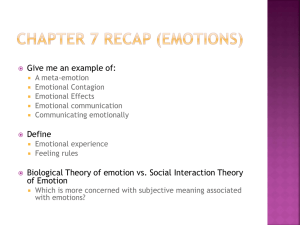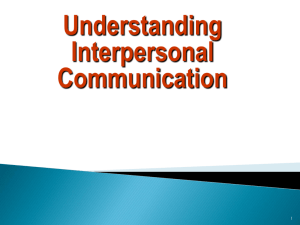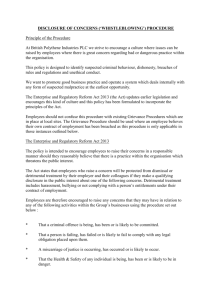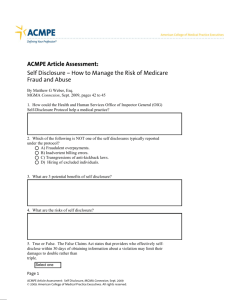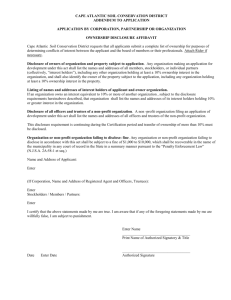Group Therapy PSY633
advertisement
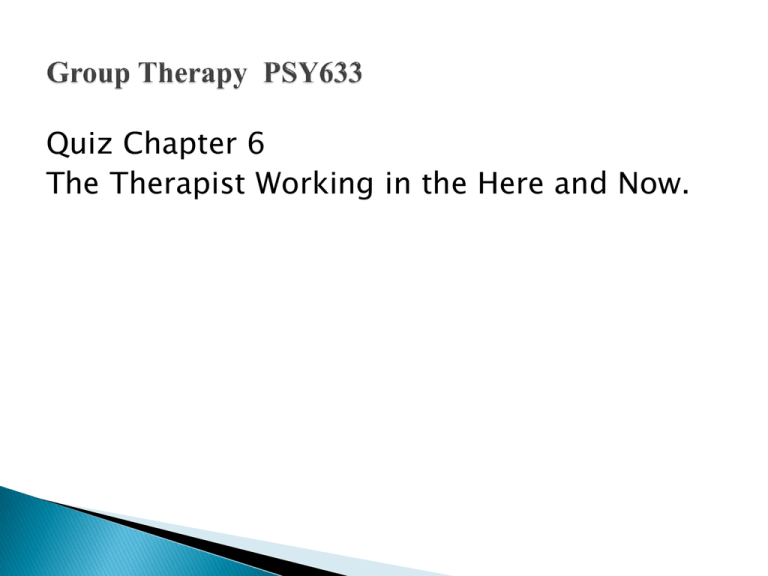
Quiz Chapter 6 The Therapist Working in the Here and Now. a. catharsis b. the social microcosm c. vertical disclosure d. metadisclosure e. illumination of process a. catharsis b. the social microcosm c. vertical disclosure d. metadisclosure e. illumination of process a. process b. metadisclosure c. horizontal disclosure d. substantive e. transactional a. process b. metadisclosure c. horizontal disclosure d. substantive e. transactional a. which one is correct b. the first event should be discussed first c. the immediate needs of the group d. reason the conflict arouse e. The willingness of the group to hear the particular interpretation a. which one is correct b. the first event should be discussed first c. the immediate needs of the group d. reason the conflict arouse e. The willingness of the group to hear the particular interpretation a. it is so common as to be banal b. people would be bored by it c. fear of retaliation d. it shows a lack of interest e. all of the above a. it is so common as to be banal b. people would be bored by it c. fear of retaliation d. it shows a lack of interest e. all of the above a. group cohesiveness b. the effectiveness of a therapy group c. arbitrary authority structure d. here and now behavior e. the group leader’s credibility a. group cohesiveness b. the effectiveness of a therapy group c. arbitrary authority structure d. here and now behavior e. the group leader’s credibility a. always expected of them b. likely to be resented by other members c. essential if the group is to have a here and now focus d. required e. the best way for members to be appreciated by other members a. always expected of them b. likely to be resented by other members c. essential if the group is to have a here and now focus d. required e. the best way for members to be appreciated by other members a. the inside to the outside b. from the specific to the abstract c. from the generic to the personal d. from the interpersonal to the personal e. all of the above a. the inside to the outside b. from the specific to the abstract c. from the generic to the personal d. from the interpersonal to the personal e. all of the above a. self-disclosure b. humor c. story telling d. the conditional verb form e. an ahistorical approach a. self-disclosure b. humor c. story telling d. the conditional verb form e. an ahistorical approach a. here and now talking b. regular attendance c. total equality toward all members d. talking about important matters e. careful listening a. here and now talking b. regular attendance c. total equality toward all members d. talking about important matters e. careful listening a. pointing out that she was working 80 hours a week b. detailing examples of her success in her career c. asking her to relate stories of success from her career d. giving her a high mark for group participation e. all of the above a. pointing out that she was working 80 hours a week b. detailing examples of her success in her career c. asking her to relate stories of success from her career d. giving her a high mark for group participation e. all of the above a. a clarification at the bottom of the page b. a note at the end of the chapter c. corroborative data and references d. a change from the first edition of the book e. an area of controversy in the field of psychotherapy a. a clarification at the bottom of the page b. a note at the end of the chapter c. corroborative data and references d. a change from the first edition of the book e. an area of controversy in the field of psychotherapy a. Think here and now b. Analyze the transference c. Use the active verb d. Use a check-in procedure e. Seek vertical disclosure a. Think here and now b. Analyze the transference c. Use the active verb d. Use a check-in procedure e. Seek vertical disclosure “Introduce Source Material Introducing source material alerts readers that you are, for the moment, no longer speaking entirely in your own voice. Quotations, paraphrases and summaries all must be properly introduced.” “Citing Source Material” “Citing means identifying for the reader the source of the quotation, paraphrase, or summary.” Label Direct Quotes “Place quotation marks around words copied verbatim (exactly) from a source, even if you've credited the author in the same sentence.” Please submit an electronic copy of your paper so that I can check for plagiarism. Please send me a copy of your certificate from the post test
